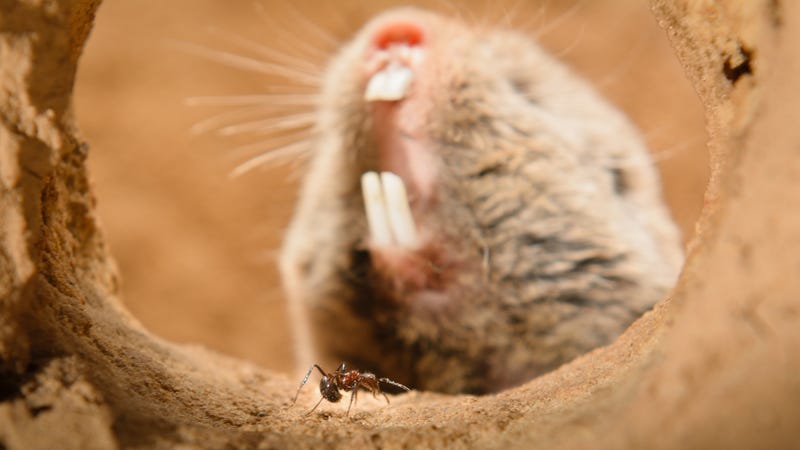
New research shows that several species of African mole-rats have evolved an uncanny ability to ward off certain types of pain, including discomfort wrought by acid, chili peppers, and hot mustard. These insights could eventually lead to advanced pain-relieving therapies in humans.
They’re not the prettiest things on the planet, but mole-rats are unquestionably cool.
The iconic naked mole-rat, with its ability to resist cancer and oxygen deprivation and seemingly death itself, tends to get much of the research attention, but there are several other species of mole-rats with plenty to offer. New research published today in Science shows that multiple species African mole-rats have acquired an insensitivity to certain kinds of pain. Genetic endowments allow these subterranean rodents to thrive in otherwise inhabitable abodes, such as burrows crawling with venomous ants.
The new study, led by Karlien Debus and Ole Eigenbrod from the Max Delbrück Center for Molecular Medicine in Germany, is a follow-up to work done on naked-mole rats back in 2008. The previous study, led by Thomas Park from the University of Illinois at Chicago, showed that naked-mole rats were surprisingly impervious to pain induced by acid and capsaicin, the latter of which gives chili peppers their heat.
The new study, which also involved Park, tested pain insensitivity across several other species of rodents, including nine species of African mole-rats and the common mouse. They wanted to explore the molecular factors responsible for pain insensitivity, with the hope that such insights could lead to the development of highly effective analgesics for people.
Advertisement

For the study, the researchers administered three substances that typically cause burning sensations in humans and other animals. Importantly, these substances weren’t chosen arbitrarily—they’re the kinds of things that mole-rats have to contend with on a regular basis. Specifically, the mole-rats were exposed to diluted hydrochloric acid (an analogue for ant venom), capsaicin (an ingredient often found in mole-rat foods), and allyl isothiocyanate AITC (an irritant found in roots—another mole-rat favorite—that gives wasabi and hot mustard their punch). In an email to Gizmodo, Debus described these substances as being all natural and with no long-term toxic properties, while adding that the experiments were approved by ethical commissions in Germany, South Africa, and Chicago.
During the behavioral assessment of pain, small amounts of these substances were injected into the paws of the animals. Rodents displayed discomfort to a compound by licking or lifting their paws, a process that typically lasted about five minutes. Animals that were impervious to the pain conducted themselves as usual, such as walking around and showing normal digging and exploratory behaviors.
Advertisement
A total of three unrelated mole-rat species, the cape mole-rat, the naked mole-rat, and the East African root rat, shrugged off the acid like it was nothing. Two species, the natal mole-rat and the naked mole-rat, showed an insensitivity to capsaicin. The highveld mole-rat was able to ward off the unpleasant effects of AITC, highlighting a unique genetic adaptation to the substance.
“Most likely, the animals have acquired this remarkable trait to adapt to living in a certain environment,” Debus told Gizmodo. “The case of the highveld mole-rat sharing its burrows with ants producing a normally painful substance is a wonderful example of how environment shapes evolution over the long term.”
Advertisement
Specifically, the highveld mole-rat was observed to co-exist with the noxious Natal droptail ants, a discovery made by Daniel Hart, a PhD student at the University of Pretoria and a co-author of the new study.
“Without the knowledge of the South African zoologists, this paper would not be the same,” said Debus. “This is what I love about the paper, how molecular biology, evolution, and zoology all come together.”
Indeed, the new study also involved some very important and revealing molecular biology. Genetic sequencing technology, along with an analysis of brain and spinal cord tissue taken from the specimens, allowed the researchers to pinpoint the genes and molecular pathways responsible for these heroic abilities.
Advertisement
“This study makes exciting insights into the biology of pain, by identifying that highveld mole-rats show no pain response to AITC, the chemical that gives wasabi and mustard their pungency,” neuropharmacologist Ewan St. John Smith from Corpus Christi College wrote in an email to Gizmodo. “This is due to increased activity of a particular molecule called NALCN in their pain-sensing nerves. The researchers used numerous techniques to attack their hypothesis from different directions, always reaching the same endpoint—that increased NALCN activity underpins the highveld mole-rat’s insensitivity to AITC,” said Smith, who wasn’t involved in the new study.
The researchers used drugs to block NALCN in the highveld mole-rats, which in turn restored the pain sensitivity to AITC and, by logical extension, to the Natal droptail ant venom. This “shows the potential for using drugs to modulate NALCN activity to treat pain in humans,” said Smith. This is good, he added, because clinicians need more weapons in their arsenal for treating pain in different people.
“[T]his study demonstrates the power of studying naturally occurring differences in pain sensitivity,” he said. “For scientists to manage in a few years what evolution has produced over millennia is perhaps an unfair challenge!”
Advertisement
https://gizmodo.com/mole-rats-are-impervious-to-many-types-of-pain-1835120342
2019-05-30 18:00:00Z
52780306355876
Tidak ada komentar:
Posting Komentar